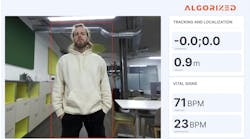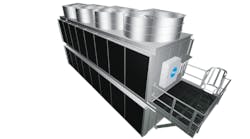At first glance, a simple beam of infrared light would seem ineffective protection against fast-moving, dangerous industrial machinery. After all, isn’t that what heavy-duty steel guards are for? Yet, these beams of infrared light, when used as a component of “safety light curtains,” have prevented thousands of employee injuries and saved countless lives.
Unlike other types of more bulky safeguards, such as physical barriers, light curtains make it easier to access equipment while performing maintenance or semi-automatic processes that require human interaction. Whether they are used to reduce exposure to point-of-operation hazards, or as a perimeter guarding device, being lightweight and compact makes light curtains ideal for machinery, robots or areas that require frequent access for purposes of material feeding, maintenance, repair, setup or the need to be adapted quickly to layout changes on a plant floor.
Light curtains are defined as being presence-sensing optoelectronic devices and are often used as a component within an overall safety system in meeting nationally recognized safety regulations and standards, such as OSHA or ANSI (B11.19-2019). The most common application of light curtains is to detect people or objects passing through a perimeter boundary, or close to protect from direct contact with a machine’s point-of-operation.
“Point of Operation” in this instance refers to where production material is being positioned for punching, bending, cutting, machining or where any type of hazardous motion is present. This is why light curtains are installed onto power presses and metal forming machines to protect the operator’s hands or fingers from crush injuries.
Transmitters and Receivers
Although light curtains come in a wide variety of designs, the two common features that make them alike are a transmitter and receiver.
Transmitters units have a series of LEDs that emit an array of synchronized, parallel infrared light beams to a separate receiver unit on the other end. The receiver has a corresponding array of photo-diodes that automatically synchronize with the transmitter LEDs, in effect, “receiving” the pulses.
Receiver circuitry is designed to detect only the specific pulse and frequency designated for it, preventing external light sources from being sensed. These systems can be mounted vertically, horizontally, or at any angle depending on the application. The only requirement is that the transmitter must align with the receiver when installed.
It is important to note that light curtains differ from other photoelectric sensors in that they have self-monitoring circuitry. When photoelectric cells from the transmitter are interrupted by an opaque object, this event triggers an output signal that is typically fed to a safety relay device delivering redundant protection.
For example, if a person steps into a prohibited zone, this safety relay would signal to the machine to stop anywhere in its cycle or stroke to prevent a potentially catastrophic accident. Light curtains should only be used on machinery that can be quickly stopped anywhere within the machine’s cycle, and should never be used on any machine with a full-revolution clutch.
Once tripped, a conscious action is required on behalf of the operator to restart the machine cycle after the source of the light curtain interruption is addressed. Prior Action Stations must be located outside yet within view of the protected area to prevent the inadvertent automatic or continuous resumption of the machine.
Depending on the light curtain and its application, a separate enclosure may hold various diagnostic indicators, power supply, user controls, and control logics that cannot be installed within the receiver.
Another light curtain design worth noting is an “active-passive system” consisting of two unique devices. One both emits and receives beams while the other device essentially acts as a mirror to deflect the beams back to the receiver.
While this approach minimizes overall costs and wiring, an active-passive system reduces the intensity of the light beam and therefore normally has a much shorter operating range than a standard system. Mirrors will reduce the operating range of a light curtain by up to 18% per mirror, depending on the type of mirror installed.
Blanking & Muting
As mentioned earlier, light curtains come in a wide variety of resolutions and IP ratings. Other more advanced features have to do with minimizing the disruption to factory flow caused by machinery being completely shut down when light beams detect an obstruction.
Two worth noting are “blanking” and “muting”—two terms that are frequently used interchangeably yet incorrectly.
Muting is the temporary automatic suspension of the entire curtain while a non-hazardous portion of the machine cycle is being performed, for example, during a press’s upstroke. Blanking is more complex. Instead of muting the entire sensing field, blanking is the bypassing of only a portion of it, leaving the rest of the light curtain active. Blanking finds utility when the material is fed through the sensing field while the machine is in motion.
Obviously, care must be taken to ensure the operator's hands, fingers or arms cannot fit through the blanked portion.
Minimum Safety Distance
When using a light curtain as a point-of-hazard safeguarding device, it's important to know and understand the stopping time of your machine. Both OSHA, ANSI, and ISO all provide formulas to calculate the safe mounting distance of a light curtain based on the stopping time of your machine.
OSHA’s formula is the base requirement, while ANSI and ISO formulas represent best safety practices, and generally result in more than a 10% increase in safe mounting distance.
Light Curtain Resolution
The resolution of a safety light curtain is its detection capability measured as the amount of separation between its laser beams. Higher-resolution light curtains improve the detection capability that can sometimes allow for the light curtain to be safely mounted closer to a hazard. While a 14-millimeter resolution is ideal for finger detection and can be deployed closer to the source of hazardous motion, a lower 25 to 30-millimeter resolution is all that is required for hand detection.
Rockford Systems strongly recommends a risk assessment prior to any light curtain installation.
Status Indicator Lights
Light curtains often feature status indicators clearly visible from a distance, preventing close proximity to dangerous machinery. Red, green, and yellow lights conveniently display operating status, configuration error codes, and blocked beams.
Questions To Consider When Selecting a Light Curtain:
- What is the stopping time of the machine or equipment? Is it sufficient to even consider a presence sensing device?
- How large is the area needing to be protected, and are there two corners or four corners?
- What is the required height of the protection field?
- What is the required operating range?
- What is the required resolution, usually measured in millimeters? The tighter the required spacing, the higher the resolution.
- What are your mounting requirements?
- What Performance Level (PL) is required?
- What environmental challenges will the light curtain face, including excessive temperatures, moisture exposure, and shock/vibration that can damage the equipment? This is often measured in IP ratings.
- What cabling and wiring are needed?
Finally, with so much on the line, it is essential to overall employee safety that you consult with an experienced machine safeguarding expert when specifying and installing a light curtain.
















